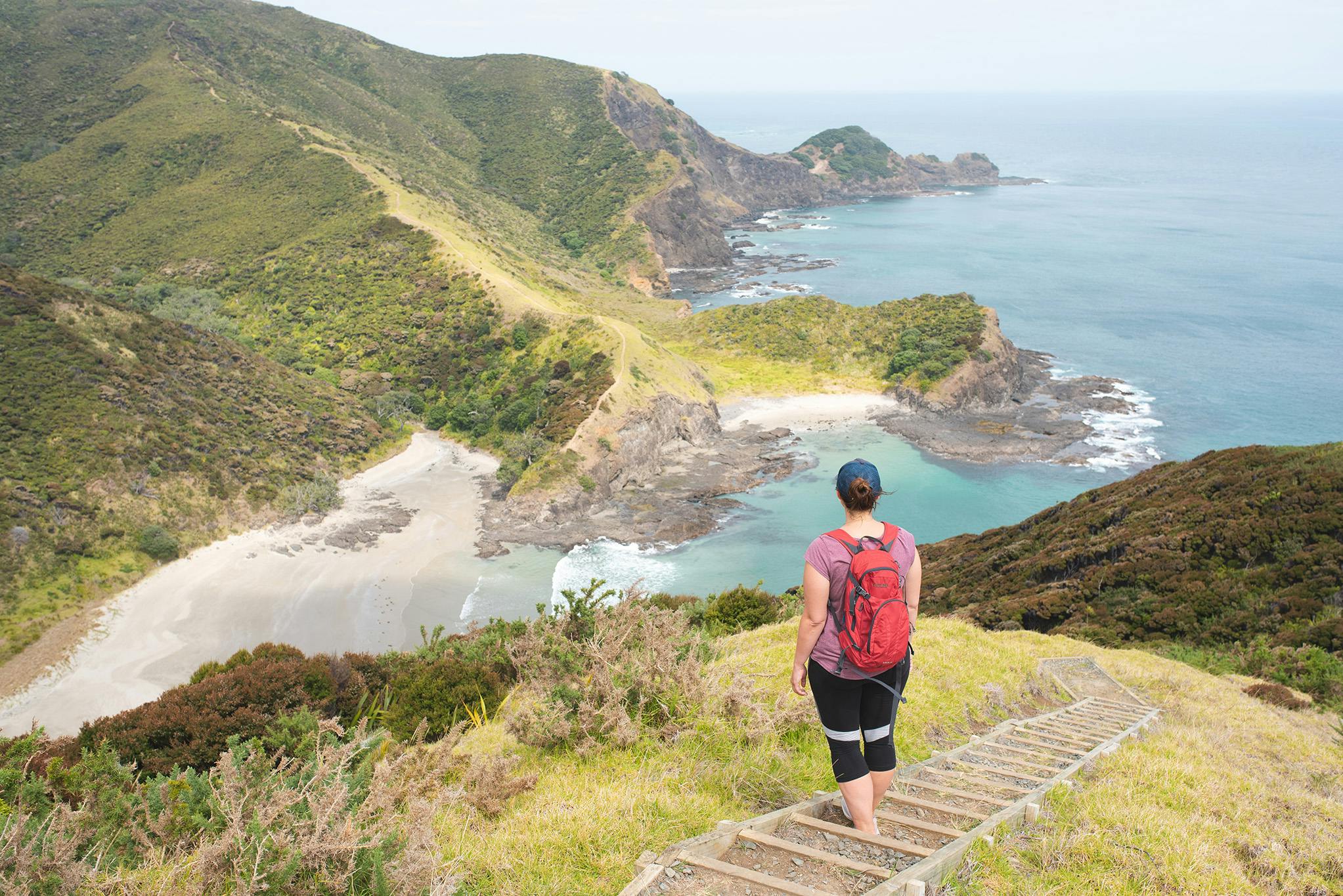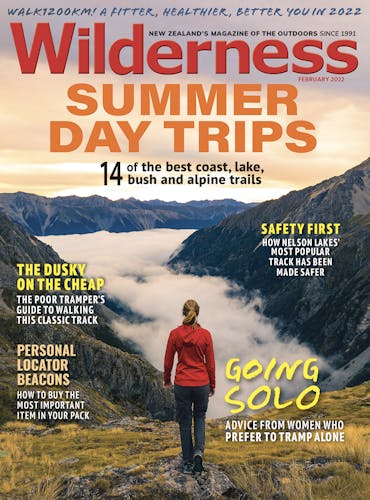Whether you want to add some distance to your Walk1200km progress tracker or to spend an enjoyable day in the bush or on the tops, these trips showcase the best of New Zealand’s coast, lake, bush and alpine environments that can be explored in just a few hours.
1. Tapotupotu Bay to Cape Reinga, Northland
Distance: 5km return Time: 4hr Grade: Easy.
By Matthew Cattin
Too few tourists venture past the Cape Reinga lighthouse which is a pity; the track leading to Tapotupotu Bay is one of the finest coastal walks in the country.
From the car park, a steady downhill ridge leads to the deeply set Sandy Bay, known for passing whales that scratch themselves on a rock protruding from the bay. Swimming here is a must – the water is turquoise and the sand a blinding white – but beware the currents which drag out to sea.
From the beach, it’s a steady and exposed climb, with over-the-shoulder views of a unique angle of Cape Reinga. The track continues east through windswept mānuka bush offering dizzying views down steep clifftops, before descending to Tapotupotu. This north-facing gem offers safer swimming and a DOC campground, though mosquitoes seem compelled to keep this paradise pristine.
Download the map and route notes for this trip here.
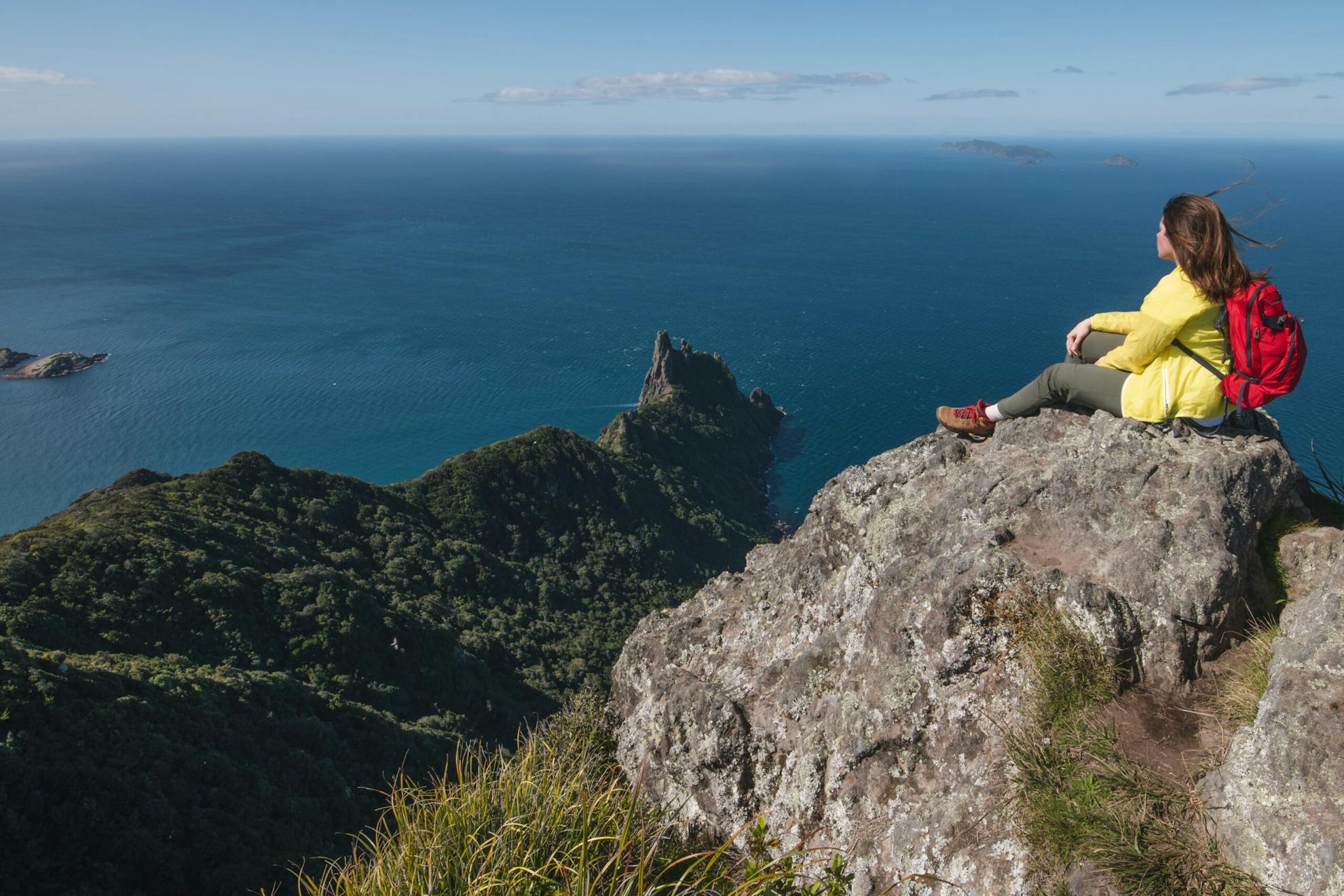
2. Te Whara Track, Northland (featured)
Distance: 7.5km return Time: 5-6hr Grade: Moderate.
By Matthew Cattin
If Bream Head is pictured as a great dragon slumbering on its belly, walking the Te Whara Track is to traverse its spine from snout to tail.
Te Whara rates amongst the best day walks in Northland. It follows in the footsteps of Māori ancestors, delivering an honest day of tramping with serious elevation changes and sets of gruelling stairs. It’s possible to walk in either direction, but, for me, beginning at Urquharts Bay is best. This allows walkers to ascend the track’s harshest stairs with fresh legs (rather than finish the day tumbling down them) and ensures the best views are faced head-on at the day’s end.
There’s no messing around; the track immediately climbs on short, sharp stairs to reveal stunning views of Smugglers Bay before plunging beneath a canopy of coastal flora. Highlights of the bush section are the occasional volcanic plugs, which rise precariously above the canopy and provide the best and only views from the middle section of the track. Serious care must be taken by anyone brave enough to climb the plugs; a slip could be fatal. The final plug, Te Whara Peak, reaches a towering 476m and shows off exhilarating 360-degree views. From here, the track descends sharply at first, before shifting to a gentle slope as it emerges from thick mānuka scrub. Here, the views are sensational, as the track meanders down an easy grass path towards Ocean Beach – one of Northland’s finest strips of pristine white sand.
Download the map and route notes for this trip here.
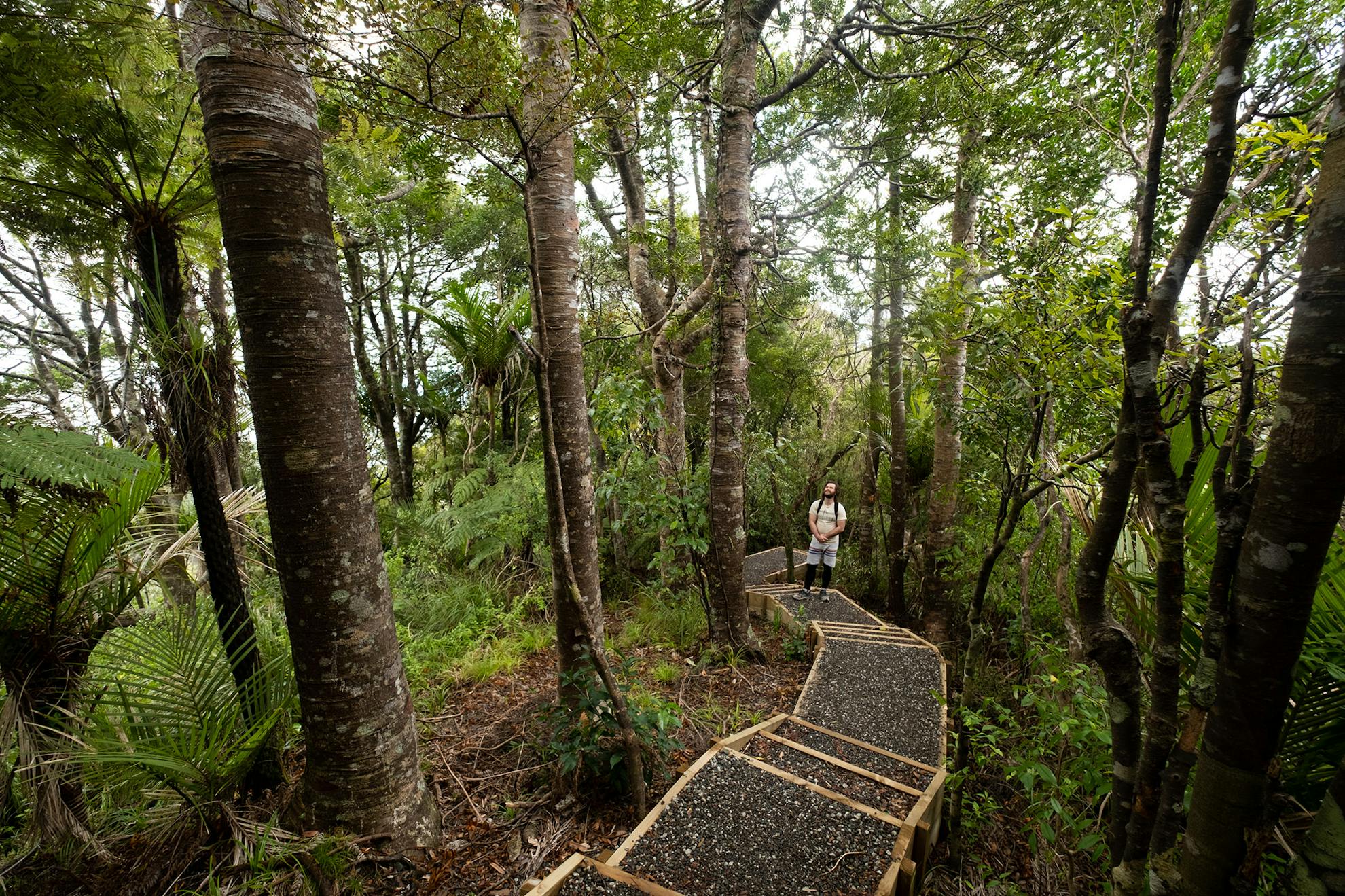
3. Whatipu to Huia, Auckland
Distance: 9.9km Time: 4-5hr Grade: Moderate.
By Matthew Cattin
The Huia to Whatipu route provides a fine day of walking in Auckland’s Waitākere Ranges. The route combines several named tracks and, if beginning at Whatipu, starts with a stunning ascent of the Omanawanui Track, which offers breathtaking views of Manukau Heads. The track climbs steadily to a trig station at 241m, though its accessible boardwalks won’t be to everyone’s tastes. Now incredibly popular, this section is best tackled early in the day.
It’s a descent from the trig to the Puriri Ridge Track. This is a more sheltered route, passing beneath a reassuring stand of healthy kauri. The few open viewpoints reveal a line of sight up the Omanawanui Valley all the way to Whatipu, a canvas of layered hills and hazy Tasman spray.
A side trip further along the track leads to Mt Donald McLean/Te-Rau-o-te-Huia, from where Rangitoto and a distant Auckland skyline can be seen over the Waitākere Ranges. From here, the descent to Huia begins on the Karamatura Track, which has historical artefacts, riverside walking, caves, rock formations and the Karamatura Falls, which plunge into a pleasant swimming hole.
Download the map and route notes for this trip here.
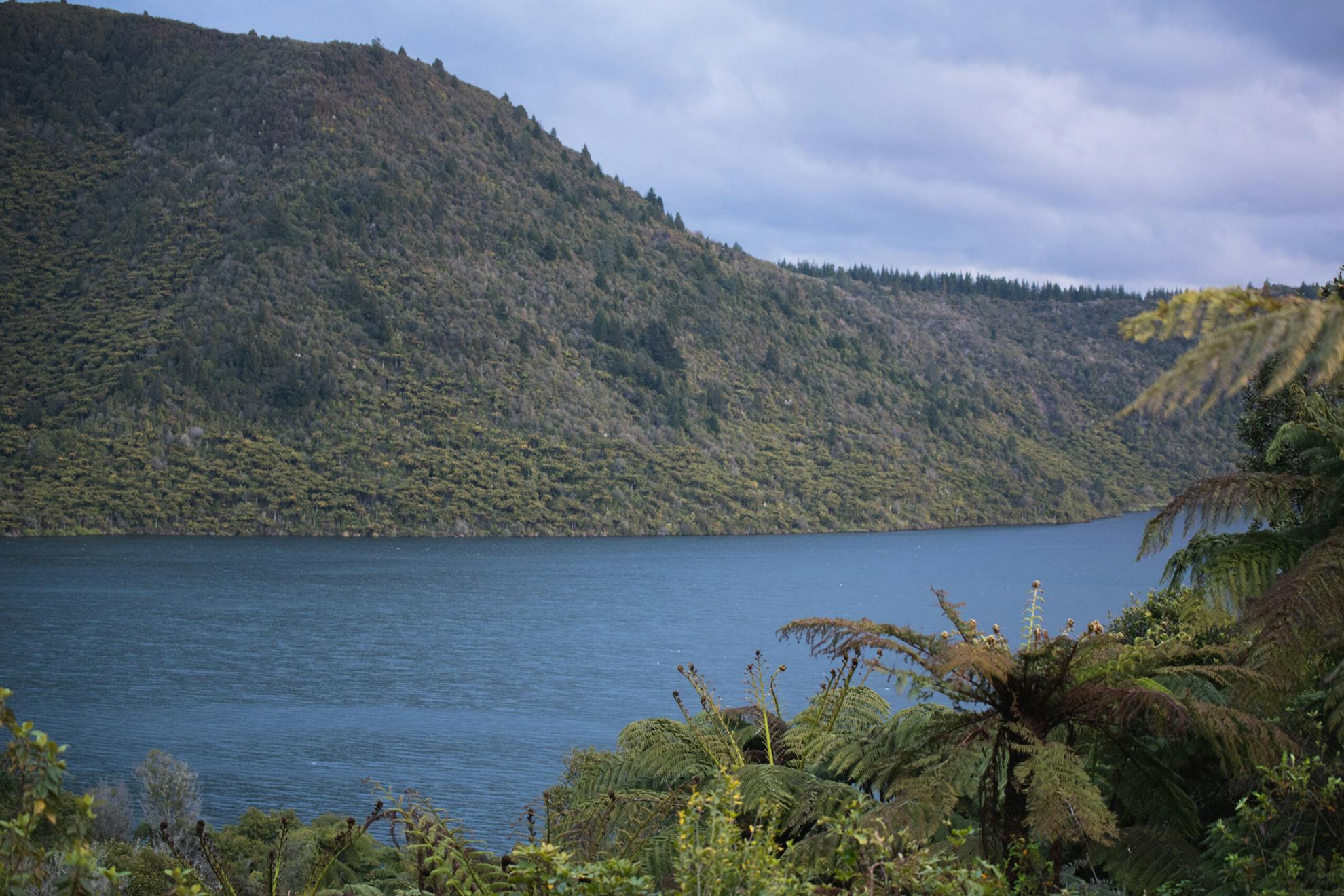
4. Tikitapu/Blue Lake Track, Rotorua
Distance: 5.5km Time: 1hr 30min Grade: Easy.
By Matthew Cattin
The Blue Lake Track, which circles Lake Tikitapu, is a welcome refuge from the bustle of Rotorua. The short loop, nestled between Whakarewarewa Forest Park and Lake Tikitapu Scenic Reserve, provides an unusual blend of native flora and redwoods, which dominate the canopy and smell delightful.
Far from strenuous, this is a track to tackle first thing in the morning or after an early dinner, while the golden light touches the surrounding hills and the lake is undisturbed by watercraft and swimmers. There are several secluded beaches on the southern edge of the lake, as well as a pleasant viewpoint from which Lake Tikitapu and Rotokakahi can be seen. The latter is tapu to local iwi and swimming is prohibited. Its shores were once well-populated by Māori, and its island, Motutawa, is an ancestral burial place. The complete loop includes a short section of roadside walking, but it is pleasant throughout nonetheless.
Download the map and route notes for this trip here.
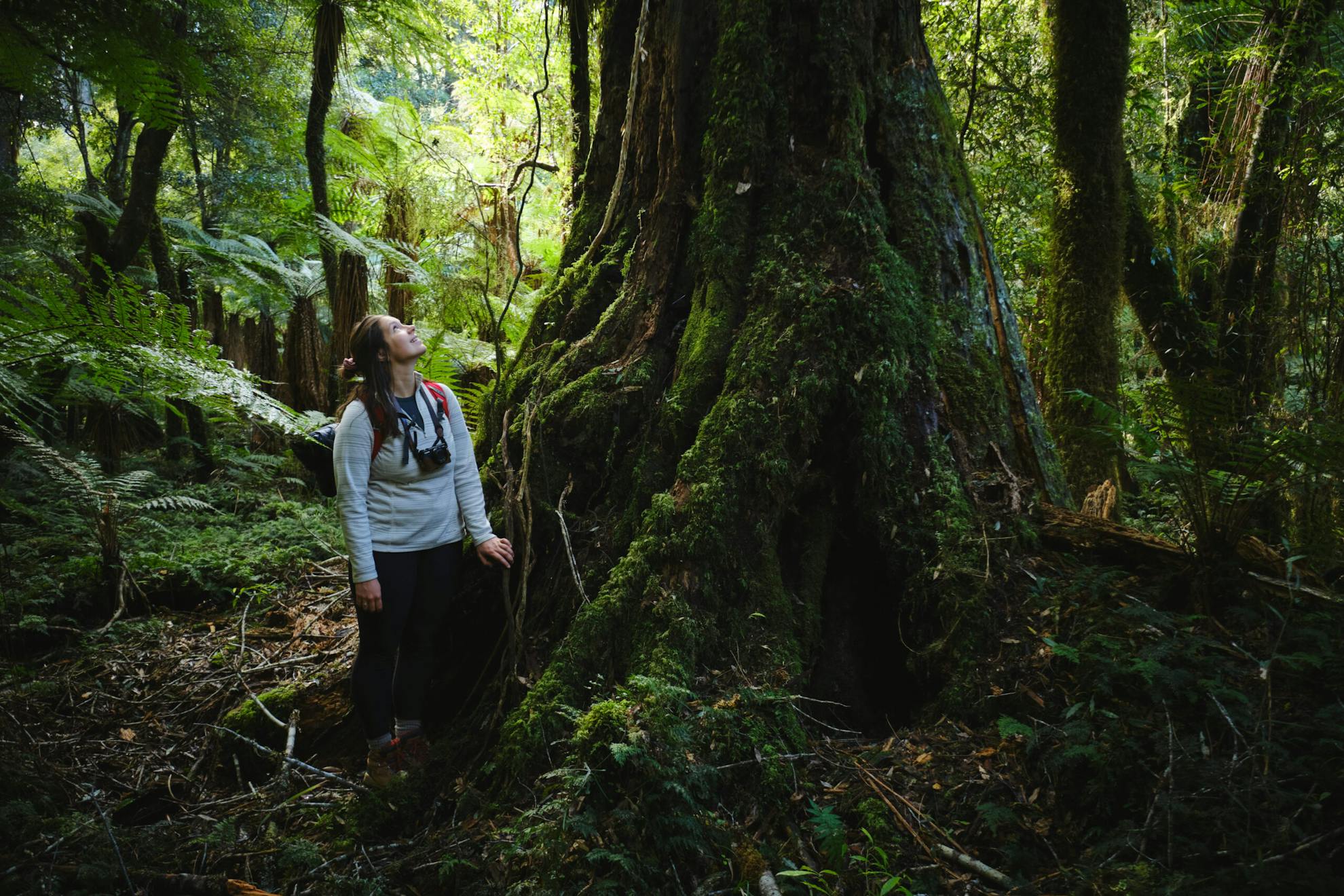
5. Whirinaki Waterfall Loop Track, East Coast
Distance: 11km Time: 3.5hr Grade: Easy.
By Matthew Cattin
No short walk showcases the ethereal wonder of Whirinaki Te Pua-a-Tāne Conservation Park better than the Waterfall Loop Track. It loops around a stunning section of the Whirinaki River, and is more of a stroll than a walk beneath humbling podocarp giants.
The wide, well-maintained, path allows walkers to float through the ancient forest, head tilted at 45-degrees to take in the full height of the enormous kahikatea, tōtara, matai and rimu.
Whirinaki River, which dawdles below the track, is rated by DOC as the best in the Bay of Plenty in which to spot whio, Aotearoa’s endangered blue duck. Whio can be difficult to spot, so it’s worth becoming familiar with the male’s shrill whistle before visiting, as this is often heard long before the ducks are seen.
Whirinaki Falls mark the halfway point but the true highlight is the Te Whaiti-Nui-A-Toi Canyon, experienced at the beginning and end of the loop. The moss-walled columns of the canyon are breathtaking and an incredible site to watch for whio.
Download the map and route notes for this trip here.
6. Mt Turiwhate, West Coast
Distance: 4km Time: 8-9hr return Grade: Difficult.
By Pat Barrett
A big climb with a big view would describe Mt Turiwhate, 1373m, on the West Coast above the banks of the Taramakau River. Though the route is tracked and untechnical, it’s rough and steep.
Beginning on the true right of Grahams Creek bridge on SH73, the route cuts through scrub then onto the riverbed where it follows a water pipe before reaching a track sign and a steady 1200m climb up the densely forested hillside.
The climb eventually tops out in the tussock and gains the ridge crest where there are stupendous views of Westland and the Southern Alps, not to mention the Taramakau Valley far below. Mt Turiwhate is an outpost, and commands a stunning spectacle, worth every drop of sweat to reach the top.
The true summit lies to the south-east and can be reached either along the ridge or by traversing any obstacles on the northern faces for an even greater spectacle of the Westland wilderness.
Download the map and route notes for this trip here.
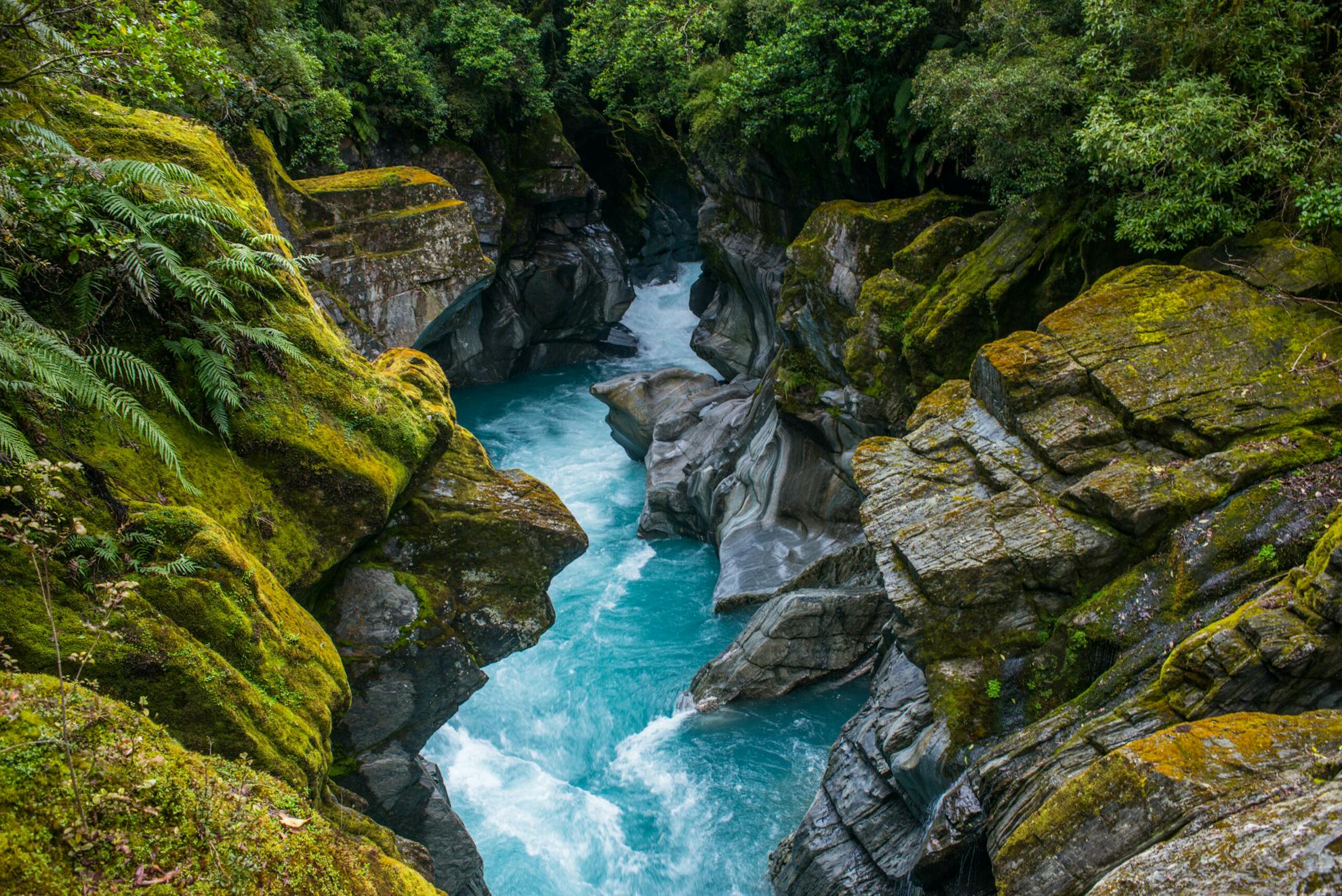
7. Whakarira Gorge, West Coast
Distance: 9km return Time: 3hr return Grade: Easy-moderate.
By Pat Barrett
This river gorge is set amid the legendary grandeur of Westland and is readily accessible from Mid Branch Road, beside the Kokatahi River (permission is required from the local farmer for access).
It’s a muddy, rocky track into the canyon with a few streams to cross and some riverside travel before the final terrace that leads through bush to a rock-walled canyon spanned by a short and airy footbridge beneath mossy rock faces.
The spectacle gained from the footbridge is of fluted rock faces, powerful azure-coloured water and tranquil pools. Log jams are often present, demonstrating the power of the big West Coast floods.
The track can be followed through rough forest to Adamson Creek (difficult in high flows) for an upstream appraisal of the canyon.
The canyon has been formed by the action of the great ice tongues that were once extruded through the basement rocks of Westland. They are common in most of the rivers here, though rarely as accessible as Whakarira Gorge.
Download the map and route notes for this trip here.
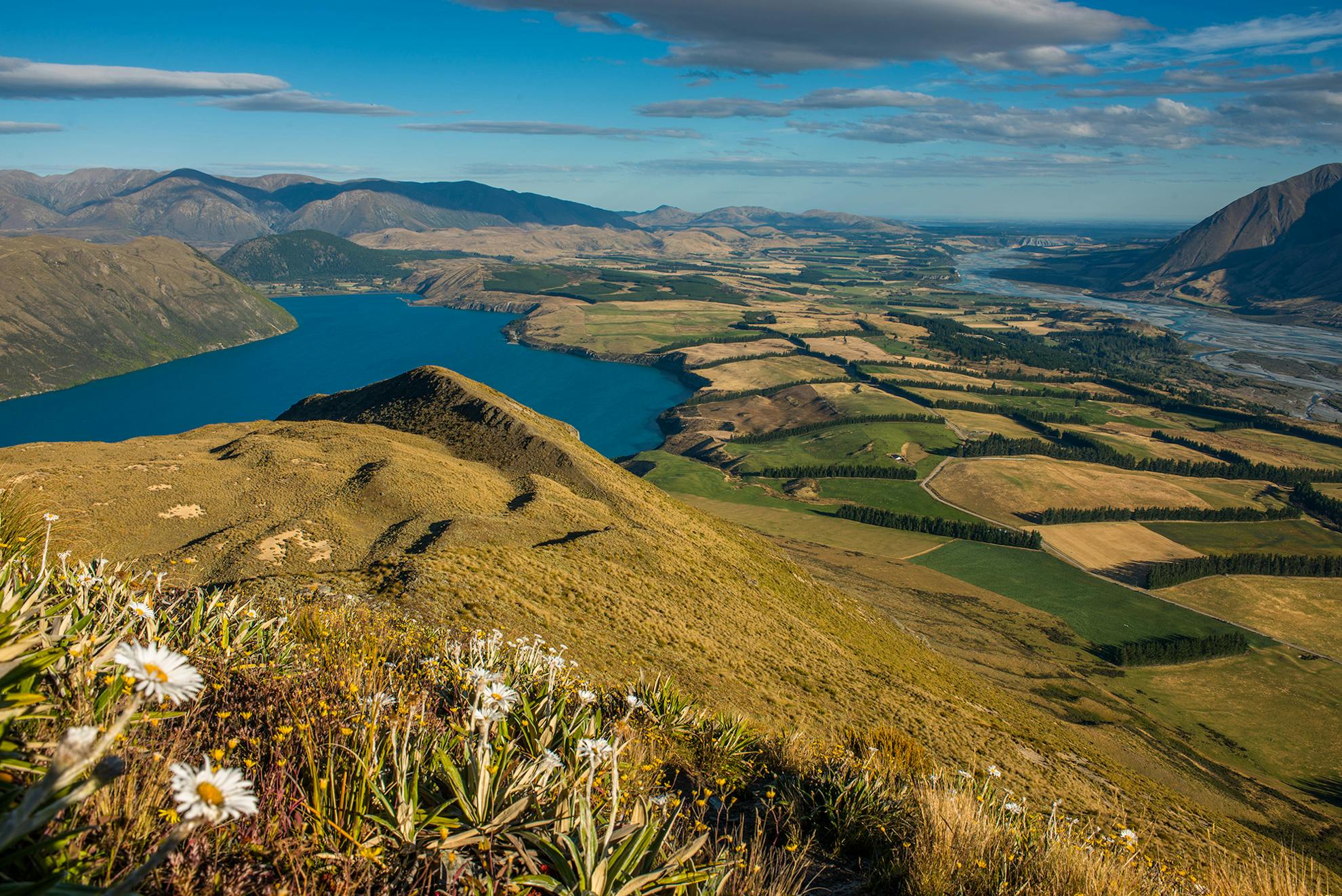
8. Peak Hill, Canterbury
Distance: 3km Time: 4-6hr return Grade: Moderate.
By Pat Barrett
Peak Hill (1240m) is amongst the best foothill viewpoints in Canterbury. It has become a sought-after destination after years of seclusion as pastoral leasehold land in the backcountry surrounding Lake Coleridge.
The climb is steady, but not relentless and is well marked. With the passing of each waypoint, the views expand with the breadth of the landscape below.
Along the southeast ridge, the track winds in, around and over several small knobs before the final short push to the broad and indistinct summit. There is nothing uncertain about the view, though: Peak Hill stands between the Rakaia and Wilberforce rivers, which flow around its eroded faces and journey on towards the plains and sea. It can all be viewed from the summit ridge.
The ragged spine of the Alps, along with many intermediate ranges and valleys, lies not far off.
The view needs time to digest, so lunch on the summit is appropriate. Take plenty of water as there’s none there.
Download the map and route notes for this trip here.
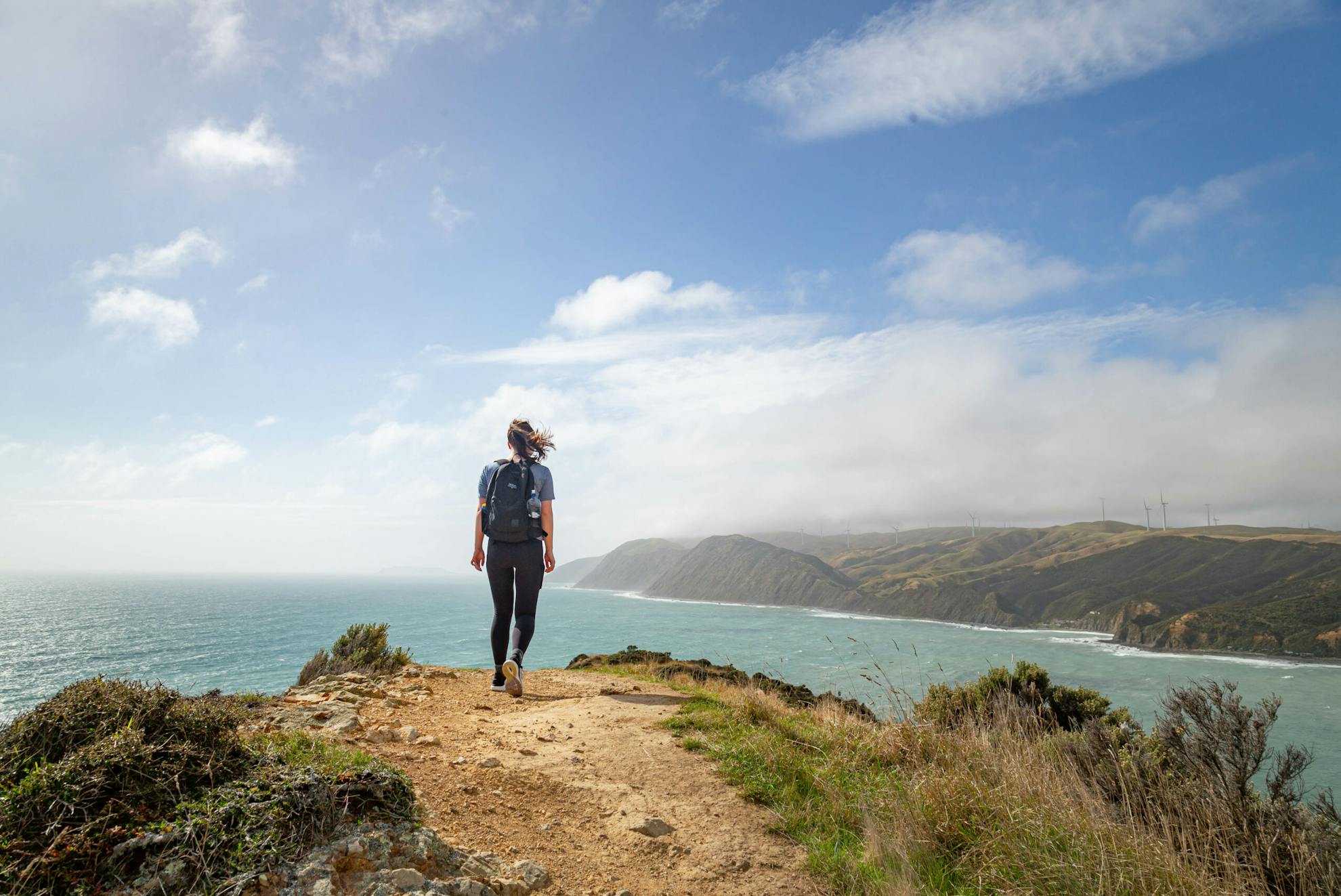
9. Mākara Walkway, Wellington
Distance: 7.3km Time: 2-3hr Grade: Easy.
By Sam Harrison
Just a stone’s throw from the glass towers of the capital, impressive towers of rock stand against the tide and waves of Cook Strait and in defiance of the ferocious northerly winds that streak through the channel separating North and South islands.
The Mākara Walkway begins at Ohariu Bay to follow the coastline south. A century ago, a community of Italian fishermen lived here, eking a living from the sea. Once at Wharehou Bay, the track takes a left and cuts up the hill exposing impressive views over Cook Strait. Those who have lived in the area have long taken advantage of the superb viewpoint, evident from both the Ngāti Ira pā site on a promontory above the bay and Fort Opau further up the hill. The fort was commissioned during the Second World War to defend Wellington from attack and was garrisoned by the 100-strong Mākara Home Guard.
Views are more expansive from the top of the hill over the surrounding country, encompassing views of Mana and Kapiti islands, Project West Wind’s turbines, the Tararua Range and the Marlborough Sounds. It would be a perfect place to watch the sunset.
From the fort, the track drops steeply to the shore at Opau Bay and an easy return along the coast to the car park.
Download the map and route notes for this trip here.
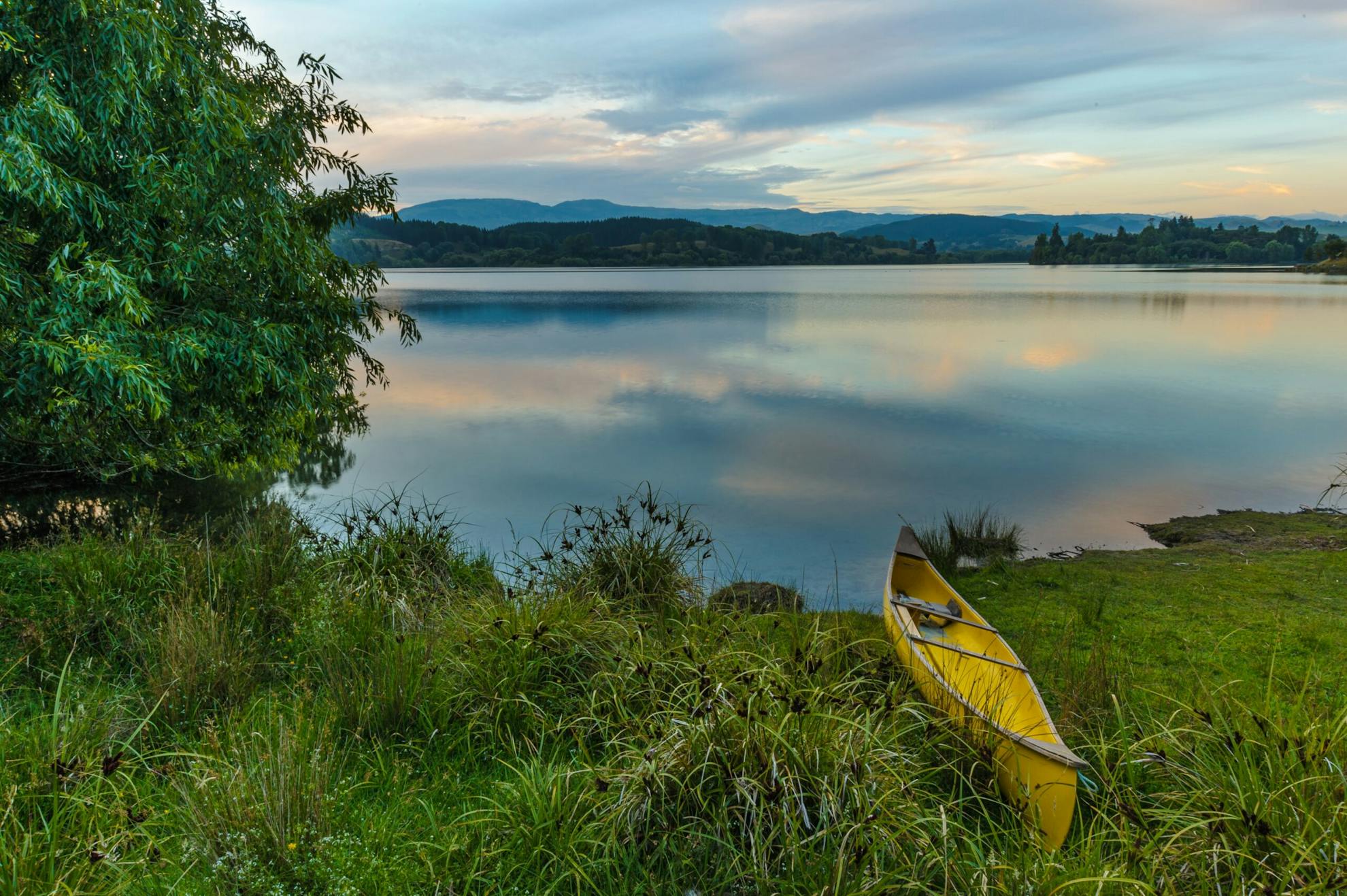
10. Tūtira Walkway, Hawke’s Bay
Distance: 9km Time: 5hr return Grade: Easy.
By Shaun Barnett
The Tūtira Walkway passes through a mixture of farmland, exotic and native forests in the hill country of Hawke’s Bay and provides views over Lake Tūtira.
The lake lies north of Napier, beside SH2, where there is a campsite and a number of walks.
The Tūtira Walkway passes through the heart of this famed sheep station, the subject of Herbert Guthrie-Smith’s well-known natural history book Tūtira, the Story of a New Zealand Sheep Station. Two routes are possible: a shorter 2hr loop or this longer 5hr one.
From the campsite, climb the trail upwards. A trig point at 494m forms the walk’s highest point. From here are views over the Kaweka and Maungaharuru ranges, before the trail descends to a shelter near Ridgemount Road. The track then traverses exotic forest into a gully and back to the lake.
Download the map and route notes for this trip here.
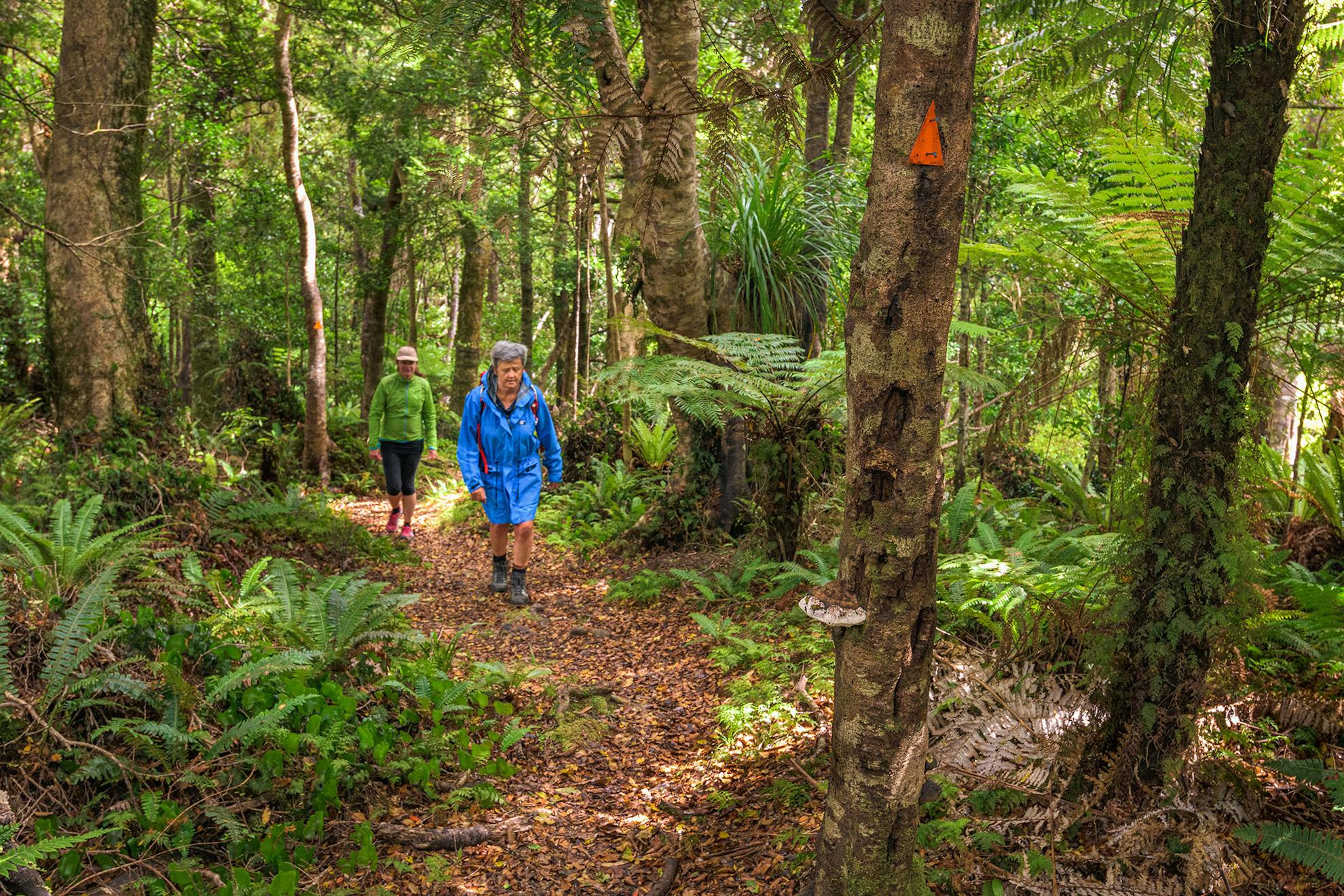
11. McKerrow, Wellington
Distance: 15km Time: 4.5–6hr Grade: Moderate.
By Shaun Barnett
This full day trip is an energetic circuit over the summit of Mt McKerrow, with a striking diversity of forests and views of Wellington Harbour.
From the Catchpool car park, walk the Ōrongorongo Track for 1-1.5hr before the signposted McKerrow Track branches off. This climbs steadily through mixed beech podocarp forest, with many ferns in the understorey and stunted mountain beech forests near the summit (706m).
Titipounamu (rifleman) are commonly heard (but less often seen) in the area.
While the summit trig offers no views, a short distance down the Clay Ridge Track is a sun-welcoming lunch spot with broad views over Wellington Harbour and sometimes the Kaikoura Ranges.
At Clay Forks, a nicely benched Graces Stream Track leads back to the car park.
Download the map and route notes for this trip here.
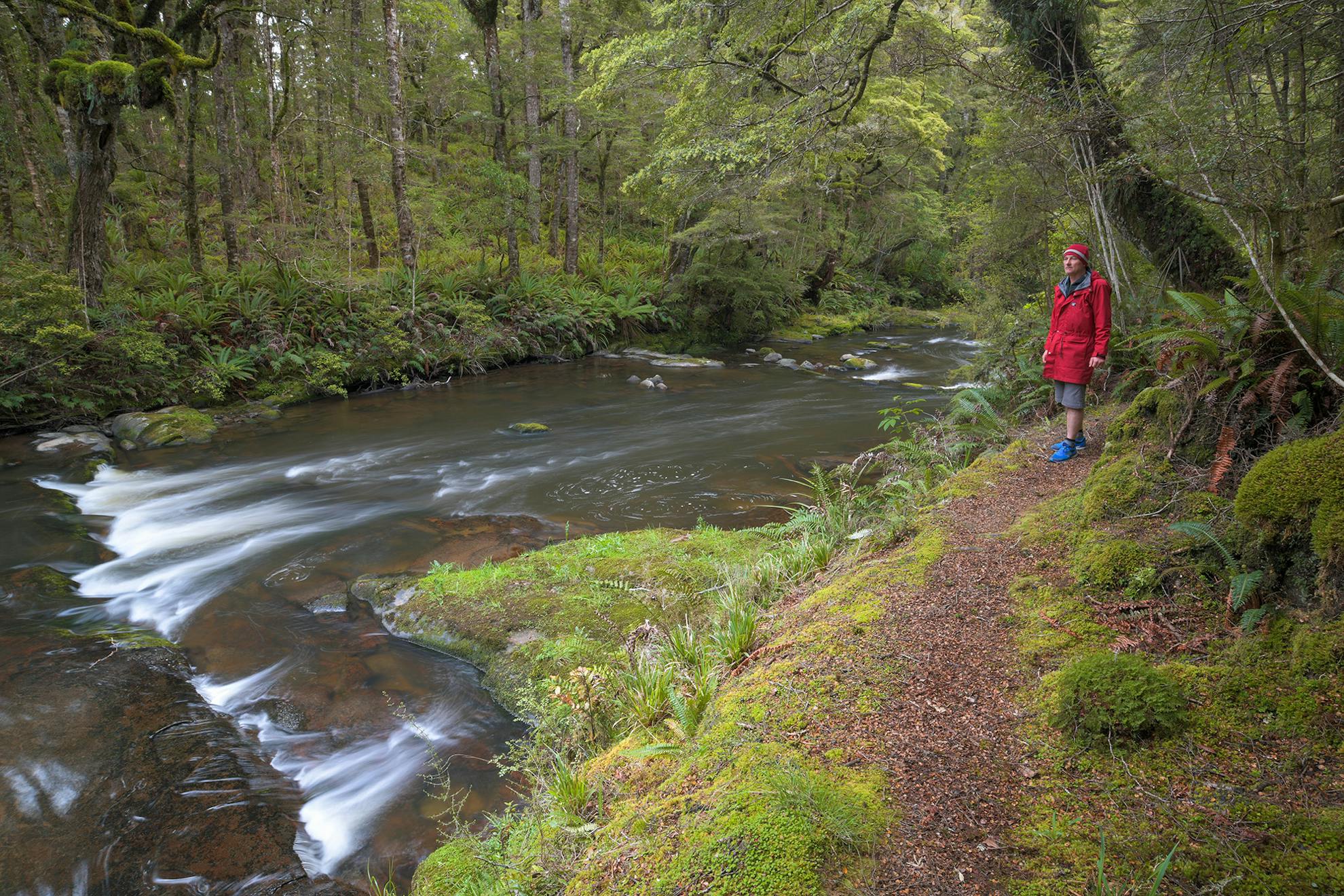
12. Catlins River Track, Otago
Distance: 11km Time: 4–5.5hr each way Grade: Easy-moderate.
By Shaun Barnett
This is an easy riverside bush track taking walkers through one of the largest remaining forested areas of the eastern South Island and passing exquisite cascades of the Catlins River. The endangered mohua/yellowhead lives in the area, so listen for its distinctive chattering call.
The Catlins River originates in the Beresford Range and gathers strength as it flows through native forest to disgorge into the tidal Catlins Lake. A pleasant track leads beside the river for a considerable length, passing through largely native beech forest.
Walking the full one-way track between The Wisp and Tawanui Campsite will require suitable transport arrangements, but shorter sections can be tackled as return journeys. The top half of the river is the more scenic, as the lower half passes sections of plantation forest. Major river crossings are bridged and in summer the native scarlet mistletoe (Peraxilla colensoi) will be in bloom.
Download the map and route notes for this trip here.
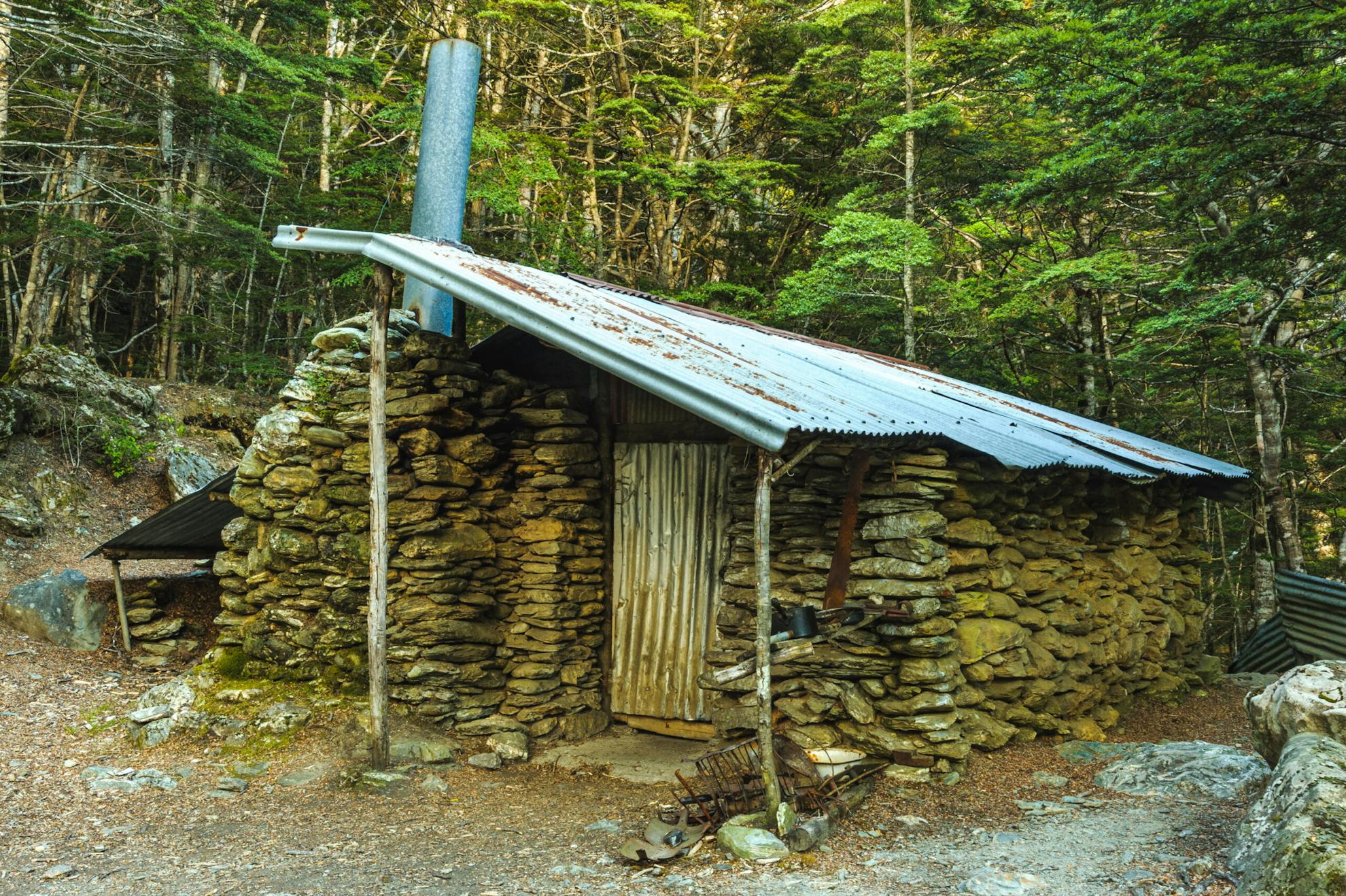
13. Sam Summers Hut, Queenstown
Distance: 7km Time: 2.5–3hr Grade: Easy-moderate.
By Shaun Barnett
Accessible near Queenstown is this rustic yesteryear gold mining hut, built from schist and iron during the 1930s by local prospector Sam Summers. Overnight use of the hut is no longer permitted, but it can still be visited as part of an enjoyable day trip around the Mt Crichton Loop.
From a car park beside the Glenorchy-Queenstown Road, take the Mt Crichton Loop Track up Twelve Mile Creek, passing a derelict hut before reaching a large excavated area, first mined in the 1860s and later sluiced. Sam Summers Hut lies just beyond, attractively positioned near a small waterfall.
The Summers brothers built the hut in 1930 and Sam lived there during the Great Depression, prospecting and hunting. After the Second World War, he kept returning to stay for decades more. Locals restored the hut in the 1980s.
Beyond the hut, cross a footbridge over the Twelve Mile and climb a zigzagging track that offers views over the narrow Lake Dispute. Above the lake, at a junction, keep on the Mt Crichton Loop Track, which descends back to the car park.
Download the map and route notes for this trip here.
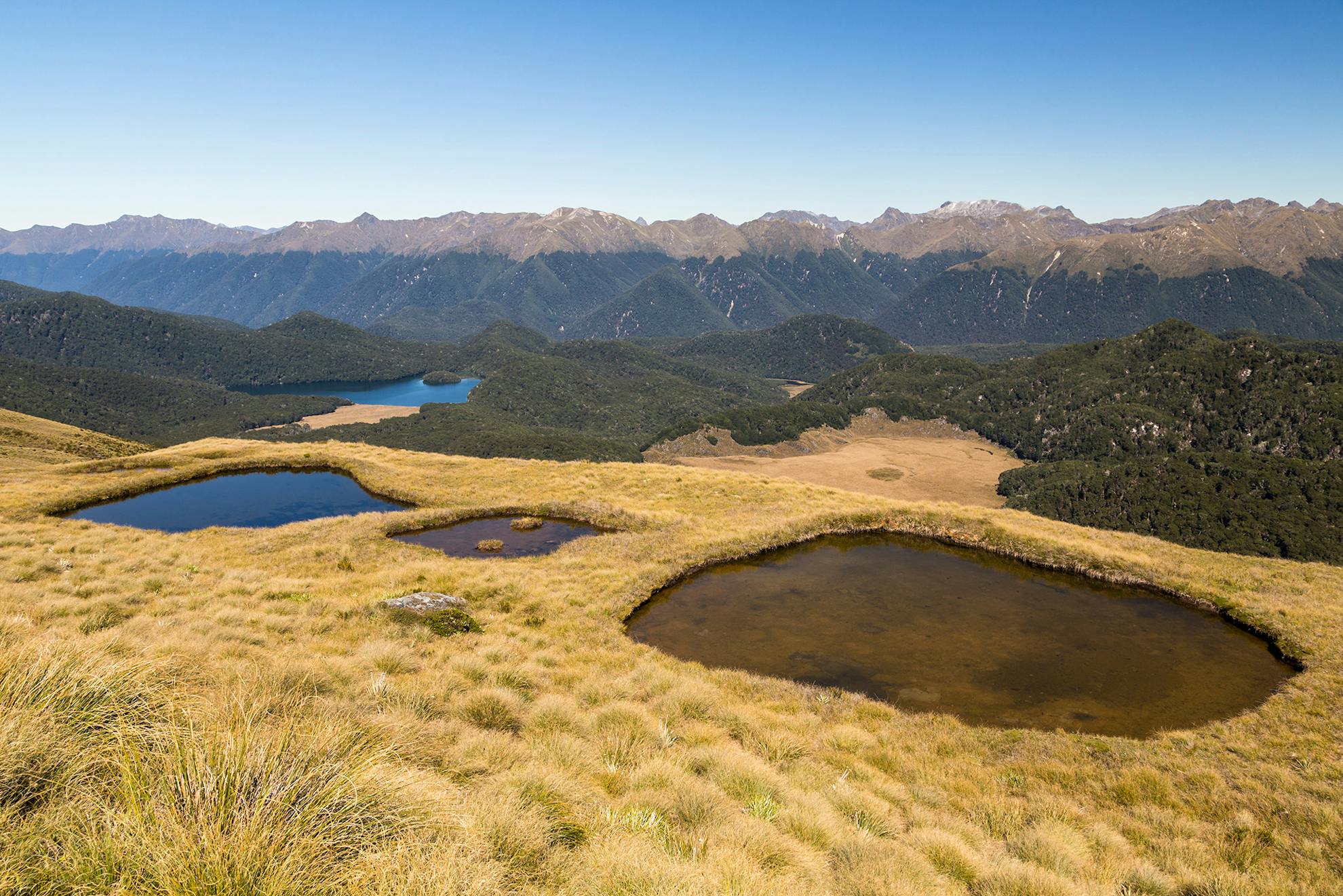
14. Mt Burns, Southland
Distance: 6km Time: 5hr return Grade: Moderate-difficult.
By Shaun Barnett
Tarns, tops, outstanding views and an easy scramble onto an accessible Fiordland summit make this an appealing day tramp.
The Borland Road provides access into the mountains south of Manapōuri. At a layby at the summit of the road, pick up a track that leads through a short section of beech forest. After a short 30-minute ascent, this opens onto tops, with views towards Island Lake. Follow the ridge on unmarked tops to reach a series of tarns. Continue the gentle climb, arcing around into a sizeable basin with more tarns directly beneath Mt Burns. The terrain becomes increasingly rocky and the scramble up the south-west ridge of Mt Burns narrows towards the granite 1645m summit.
Expansive views unfold. Green Lake, formed by a colossal landslide 13,000 years ago, lies in a large depression, surrounded by the innumerable summits of the great, vast Fiordland wilderness.
Download the map and route notes for this trip here.





